Information Management and Decision Making Report - Rowlinson Knitwear
VerifiedAdded on 2023/01/10
|14
|4266
|95
Report
AI Summary
This report examines information management and its impact on decision-making within the context of Rowlinson Knitwear, a UK-based clothing manufacturer. The report covers the process of converting data into information, understanding, knowledge, and wisdom, identifying key features at each stage. It also details criteria for selecting data, describes the functions of a Management Information System (MIS) and its impact on organizational efficiency, and outlines organizational responsibilities for information sourcing, sharing, and storage to ensure legal compliance. Furthermore, the report discusses different types of information offered to employees, access procedures, and the effectiveness of various information formats. It analyzes organizational patterns and trends, evaluates decision-making tools, and emphasizes the importance of valid management information for future planning. Finally, the report reviews methods for data collection to inform strategic decisions and analyzes the impact of information on strategic management decisions.
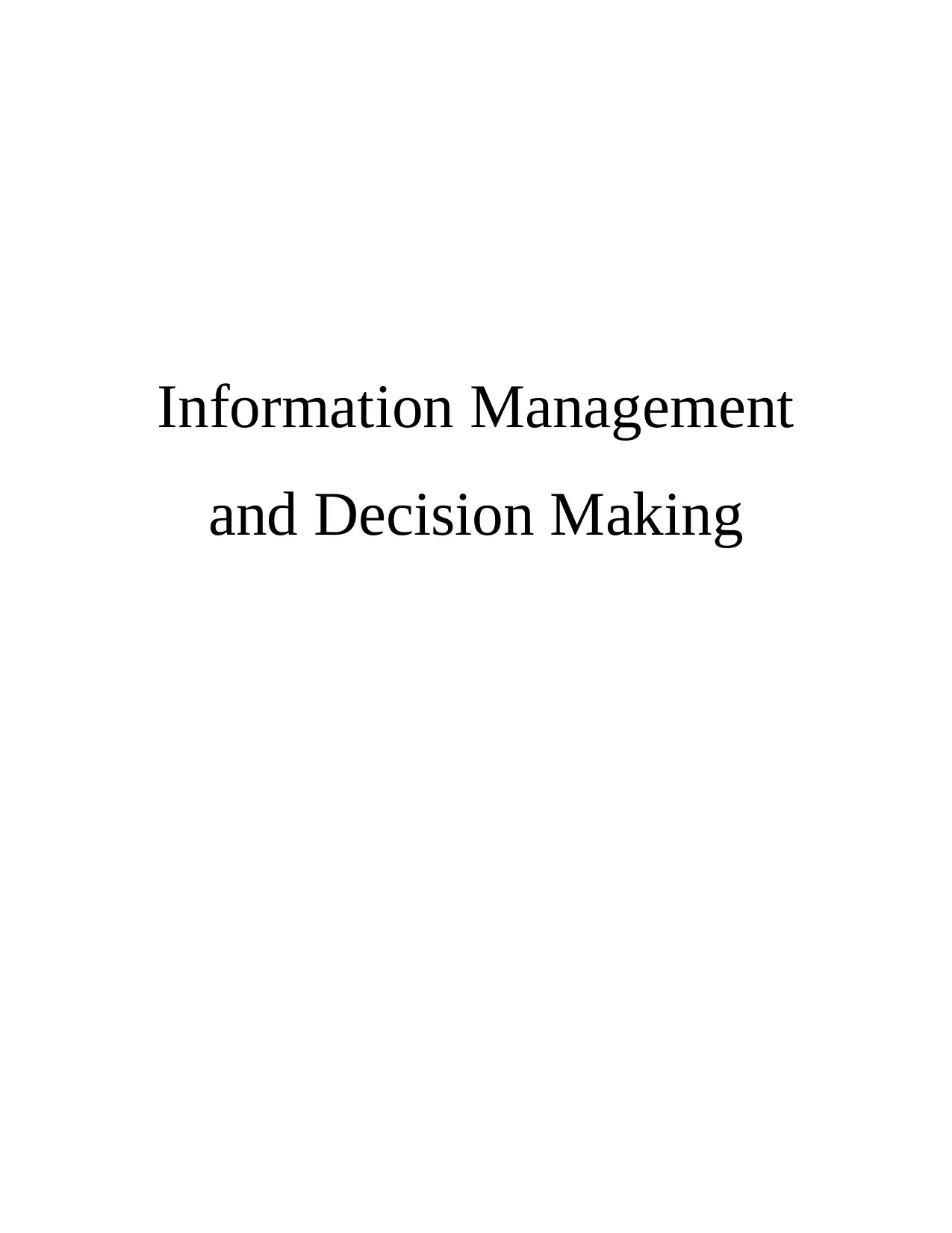
Information Management
and Decision Making
and Decision Making
Paraphrase This Document
Need a fresh take? Get an instant paraphrase of this document with our AI Paraphraser
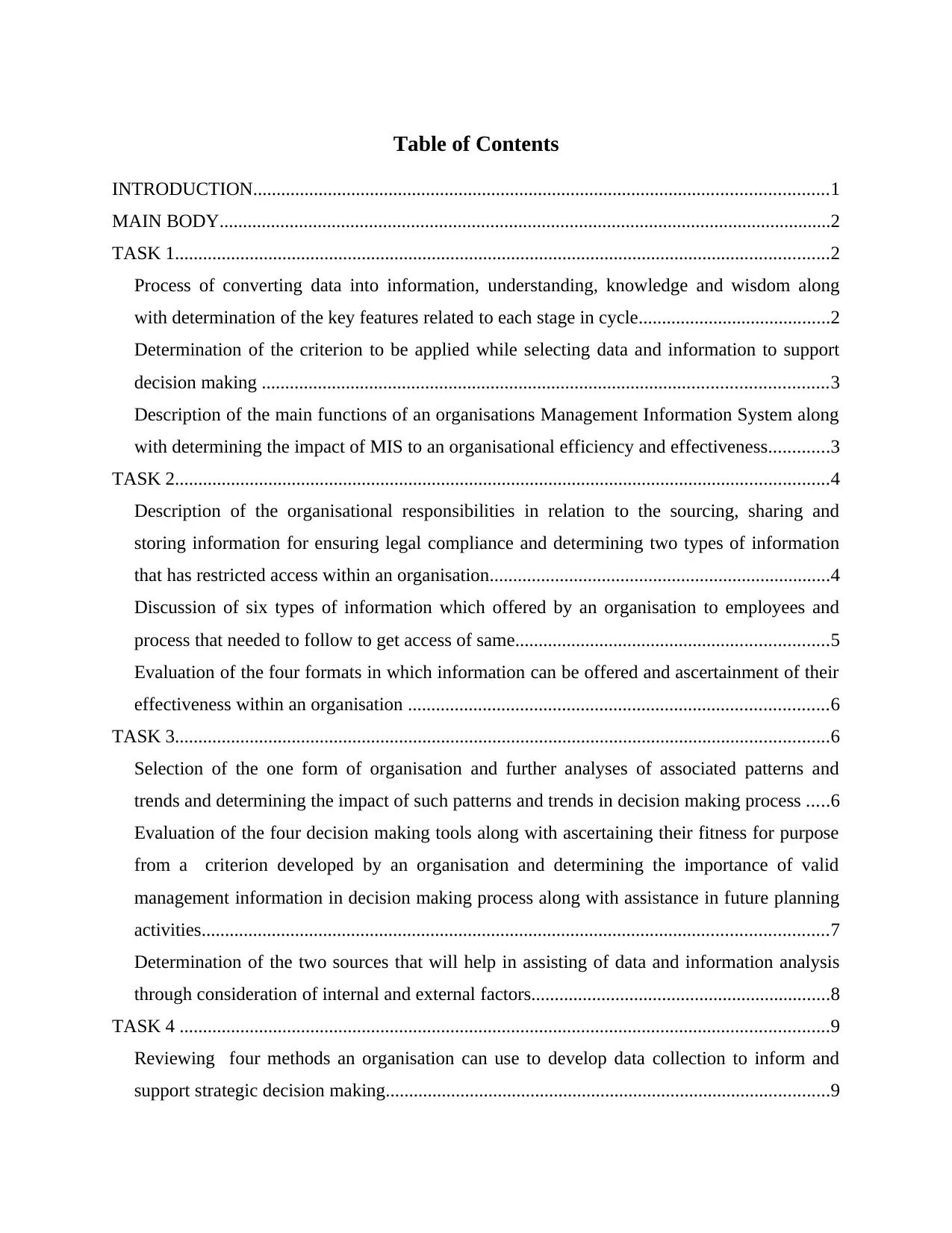
Table of Contents
INTRODUCTION...........................................................................................................................1
MAIN BODY...................................................................................................................................2
TASK 1............................................................................................................................................2
Process of converting data into information, understanding, knowledge and wisdom along
with determination of the key features related to each stage in cycle.........................................2
Determination of the criterion to be applied while selecting data and information to support
decision making .........................................................................................................................3
Description of the main functions of an organisations Management Information System along
with determining the impact of MIS to an organisational efficiency and effectiveness.............3
TASK 2............................................................................................................................................4
Description of the organisational responsibilities in relation to the sourcing, sharing and
storing information for ensuring legal compliance and determining two types of information
that has restricted access within an organisation.........................................................................4
Discussion of six types of information which offered by an organisation to employees and
process that needed to follow to get access of same...................................................................5
Evaluation of the four formats in which information can be offered and ascertainment of their
effectiveness within an organisation ..........................................................................................6
TASK 3............................................................................................................................................6
Selection of the one form of organisation and further analyses of associated patterns and
trends and determining the impact of such patterns and trends in decision making process .....6
Evaluation of the four decision making tools along with ascertaining their fitness for purpose
from a criterion developed by an organisation and determining the importance of valid
management information in decision making process along with assistance in future planning
activities......................................................................................................................................7
Determination of the two sources that will help in assisting of data and information analysis
through consideration of internal and external factors................................................................8
TASK 4 ...........................................................................................................................................9
Reviewing four methods an organisation can use to develop data collection to inform and
support strategic decision making...............................................................................................9
INTRODUCTION...........................................................................................................................1
MAIN BODY...................................................................................................................................2
TASK 1............................................................................................................................................2
Process of converting data into information, understanding, knowledge and wisdom along
with determination of the key features related to each stage in cycle.........................................2
Determination of the criterion to be applied while selecting data and information to support
decision making .........................................................................................................................3
Description of the main functions of an organisations Management Information System along
with determining the impact of MIS to an organisational efficiency and effectiveness.............3
TASK 2............................................................................................................................................4
Description of the organisational responsibilities in relation to the sourcing, sharing and
storing information for ensuring legal compliance and determining two types of information
that has restricted access within an organisation.........................................................................4
Discussion of six types of information which offered by an organisation to employees and
process that needed to follow to get access of same...................................................................5
Evaluation of the four formats in which information can be offered and ascertainment of their
effectiveness within an organisation ..........................................................................................6
TASK 3............................................................................................................................................6
Selection of the one form of organisation and further analyses of associated patterns and
trends and determining the impact of such patterns and trends in decision making process .....6
Evaluation of the four decision making tools along with ascertaining their fitness for purpose
from a criterion developed by an organisation and determining the importance of valid
management information in decision making process along with assistance in future planning
activities......................................................................................................................................7
Determination of the two sources that will help in assisting of data and information analysis
through consideration of internal and external factors................................................................8
TASK 4 ...........................................................................................................................................9
Reviewing four methods an organisation can use to develop data collection to inform and
support strategic decision making...............................................................................................9
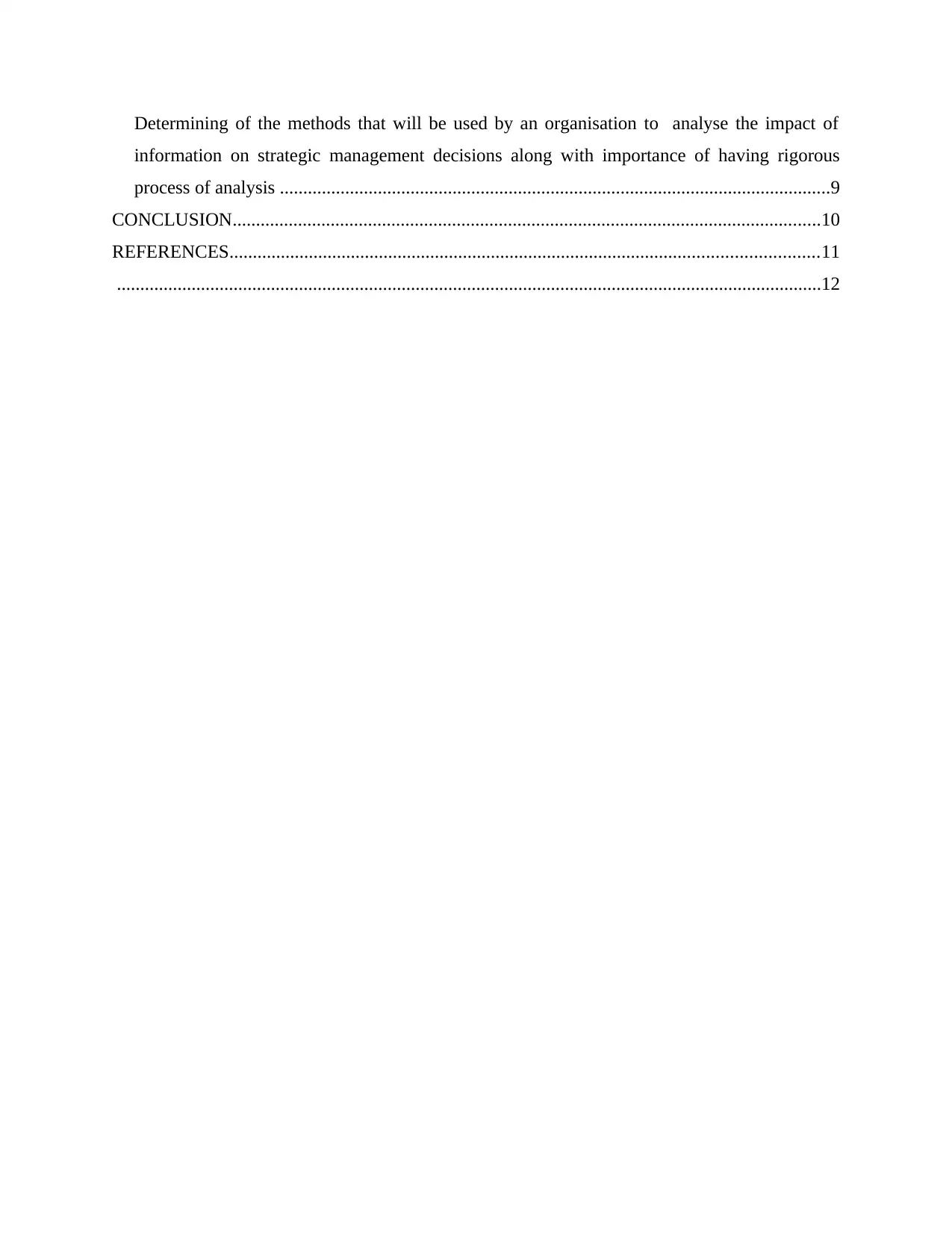
Determining of the methods that will be used by an organisation to analyse the impact of
information on strategic management decisions along with importance of having rigorous
process of analysis ......................................................................................................................9
CONCLUSION..............................................................................................................................10
REFERENCES..............................................................................................................................11
.......................................................................................................................................................12
information on strategic management decisions along with importance of having rigorous
process of analysis ......................................................................................................................9
CONCLUSION..............................................................................................................................10
REFERENCES..............................................................................................................................11
.......................................................................................................................................................12
⊘ This is a preview!⊘
Do you want full access?
Subscribe today to unlock all pages.

Trusted by 1+ million students worldwide
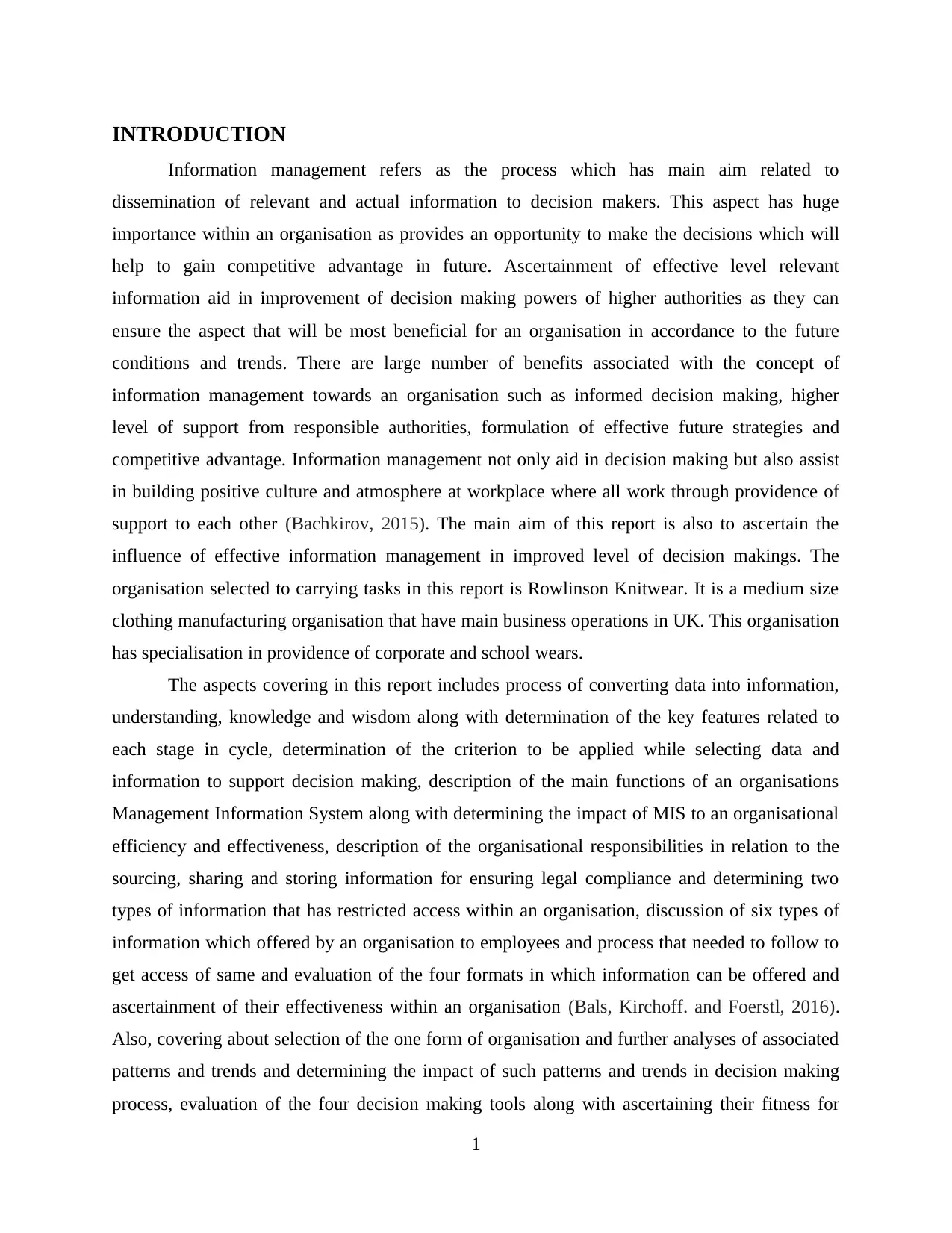
INTRODUCTION
Information management refers as the process which has main aim related to
dissemination of relevant and actual information to decision makers. This aspect has huge
importance within an organisation as provides an opportunity to make the decisions which will
help to gain competitive advantage in future. Ascertainment of effective level relevant
information aid in improvement of decision making powers of higher authorities as they can
ensure the aspect that will be most beneficial for an organisation in accordance to the future
conditions and trends. There are large number of benefits associated with the concept of
information management towards an organisation such as informed decision making, higher
level of support from responsible authorities, formulation of effective future strategies and
competitive advantage. Information management not only aid in decision making but also assist
in building positive culture and atmosphere at workplace where all work through providence of
support to each other (Bachkirov, 2015). The main aim of this report is also to ascertain the
influence of effective information management in improved level of decision makings. The
organisation selected to carrying tasks in this report is Rowlinson Knitwear. It is a medium size
clothing manufacturing organisation that have main business operations in UK. This organisation
has specialisation in providence of corporate and school wears.
The aspects covering in this report includes process of converting data into information,
understanding, knowledge and wisdom along with determination of the key features related to
each stage in cycle, determination of the criterion to be applied while selecting data and
information to support decision making, description of the main functions of an organisations
Management Information System along with determining the impact of MIS to an organisational
efficiency and effectiveness, description of the organisational responsibilities in relation to the
sourcing, sharing and storing information for ensuring legal compliance and determining two
types of information that has restricted access within an organisation, discussion of six types of
information which offered by an organisation to employees and process that needed to follow to
get access of same and evaluation of the four formats in which information can be offered and
ascertainment of their effectiveness within an organisation (Bals, Kirchoff. and Foerstl, 2016).
Also, covering about selection of the one form of organisation and further analyses of associated
patterns and trends and determining the impact of such patterns and trends in decision making
process, evaluation of the four decision making tools along with ascertaining their fitness for
1
Information management refers as the process which has main aim related to
dissemination of relevant and actual information to decision makers. This aspect has huge
importance within an organisation as provides an opportunity to make the decisions which will
help to gain competitive advantage in future. Ascertainment of effective level relevant
information aid in improvement of decision making powers of higher authorities as they can
ensure the aspect that will be most beneficial for an organisation in accordance to the future
conditions and trends. There are large number of benefits associated with the concept of
information management towards an organisation such as informed decision making, higher
level of support from responsible authorities, formulation of effective future strategies and
competitive advantage. Information management not only aid in decision making but also assist
in building positive culture and atmosphere at workplace where all work through providence of
support to each other (Bachkirov, 2015). The main aim of this report is also to ascertain the
influence of effective information management in improved level of decision makings. The
organisation selected to carrying tasks in this report is Rowlinson Knitwear. It is a medium size
clothing manufacturing organisation that have main business operations in UK. This organisation
has specialisation in providence of corporate and school wears.
The aspects covering in this report includes process of converting data into information,
understanding, knowledge and wisdom along with determination of the key features related to
each stage in cycle, determination of the criterion to be applied while selecting data and
information to support decision making, description of the main functions of an organisations
Management Information System along with determining the impact of MIS to an organisational
efficiency and effectiveness, description of the organisational responsibilities in relation to the
sourcing, sharing and storing information for ensuring legal compliance and determining two
types of information that has restricted access within an organisation, discussion of six types of
information which offered by an organisation to employees and process that needed to follow to
get access of same and evaluation of the four formats in which information can be offered and
ascertainment of their effectiveness within an organisation (Bals, Kirchoff. and Foerstl, 2016).
Also, covering about selection of the one form of organisation and further analyses of associated
patterns and trends and determining the impact of such patterns and trends in decision making
process, evaluation of the four decision making tools along with ascertaining their fitness for
1
Paraphrase This Document
Need a fresh take? Get an instant paraphrase of this document with our AI Paraphraser
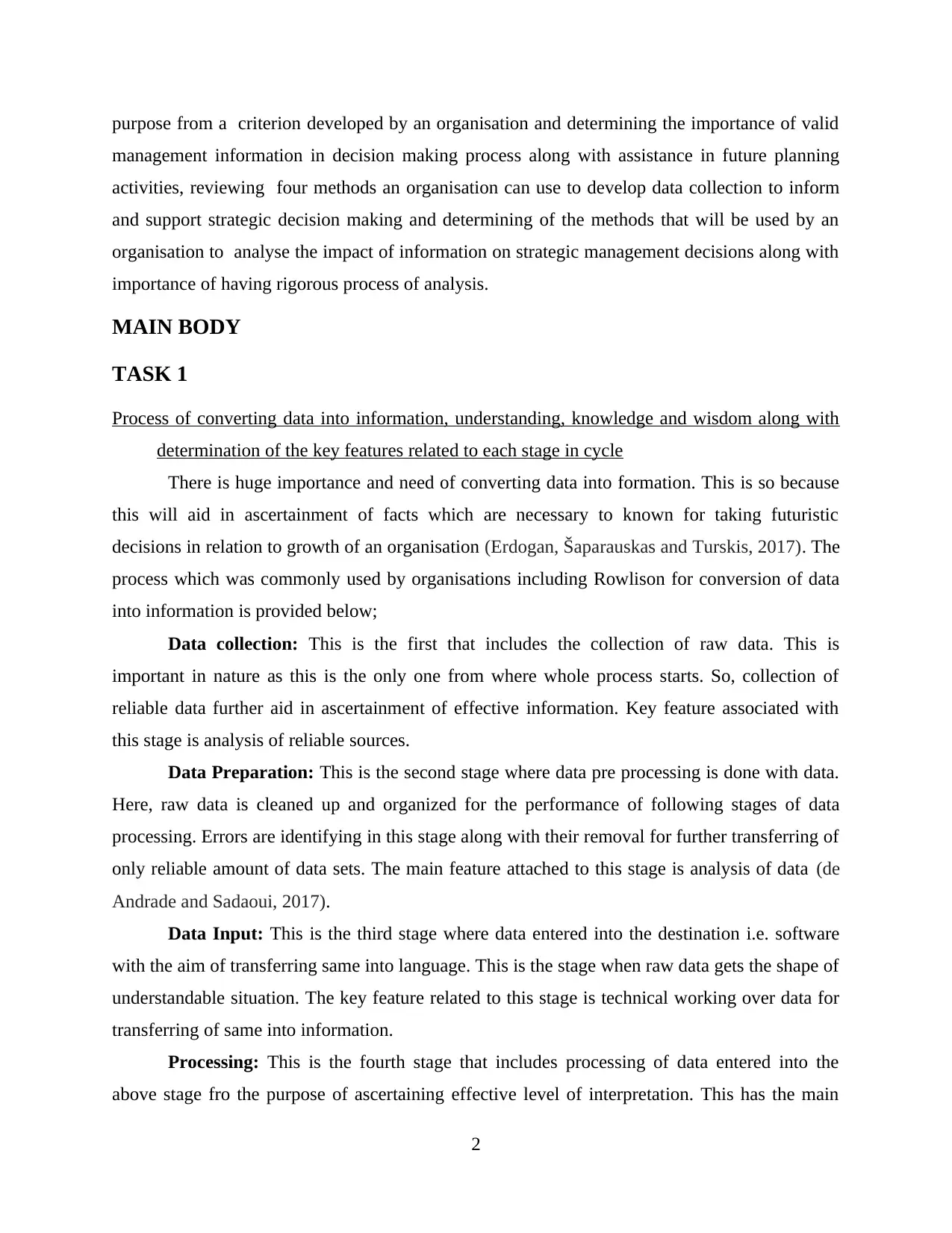
purpose from a criterion developed by an organisation and determining the importance of valid
management information in decision making process along with assistance in future planning
activities, reviewing four methods an organisation can use to develop data collection to inform
and support strategic decision making and determining of the methods that will be used by an
organisation to analyse the impact of information on strategic management decisions along with
importance of having rigorous process of analysis.
MAIN BODY
TASK 1
Process of converting data into information, understanding, knowledge and wisdom along with
determination of the key features related to each stage in cycle
There is huge importance and need of converting data into formation. This is so because
this will aid in ascertainment of facts which are necessary to known for taking futuristic
decisions in relation to growth of an organisation (Erdogan, Šaparauskas and Turskis, 2017). The
process which was commonly used by organisations including Rowlison for conversion of data
into information is provided below;
Data collection: This is the first that includes the collection of raw data. This is
important in nature as this is the only one from where whole process starts. So, collection of
reliable data further aid in ascertainment of effective information. Key feature associated with
this stage is analysis of reliable sources.
Data Preparation: This is the second stage where data pre processing is done with data.
Here, raw data is cleaned up and organized for the performance of following stages of data
processing. Errors are identifying in this stage along with their removal for further transferring of
only reliable amount of data sets. The main feature attached to this stage is analysis of data (de
Andrade and Sadaoui, 2017).
Data Input: This is the third stage where data entered into the destination i.e. software
with the aim of transferring same into language. This is the stage when raw data gets the shape of
understandable situation. The key feature related to this stage is technical working over data for
transferring of same into information.
Processing: This is the fourth stage that includes processing of data entered into the
above stage fro the purpose of ascertaining effective level of interpretation. This has the main
2
management information in decision making process along with assistance in future planning
activities, reviewing four methods an organisation can use to develop data collection to inform
and support strategic decision making and determining of the methods that will be used by an
organisation to analyse the impact of information on strategic management decisions along with
importance of having rigorous process of analysis.
MAIN BODY
TASK 1
Process of converting data into information, understanding, knowledge and wisdom along with
determination of the key features related to each stage in cycle
There is huge importance and need of converting data into formation. This is so because
this will aid in ascertainment of facts which are necessary to known for taking futuristic
decisions in relation to growth of an organisation (Erdogan, Šaparauskas and Turskis, 2017). The
process which was commonly used by organisations including Rowlison for conversion of data
into information is provided below;
Data collection: This is the first that includes the collection of raw data. This is
important in nature as this is the only one from where whole process starts. So, collection of
reliable data further aid in ascertainment of effective information. Key feature associated with
this stage is analysis of reliable sources.
Data Preparation: This is the second stage where data pre processing is done with data.
Here, raw data is cleaned up and organized for the performance of following stages of data
processing. Errors are identifying in this stage along with their removal for further transferring of
only reliable amount of data sets. The main feature attached to this stage is analysis of data (de
Andrade and Sadaoui, 2017).
Data Input: This is the third stage where data entered into the destination i.e. software
with the aim of transferring same into language. This is the stage when raw data gets the shape of
understandable situation. The key feature related to this stage is technical working over data for
transferring of same into information.
Processing: This is the fourth stage that includes processing of data entered into the
above stage fro the purpose of ascertaining effective level of interpretation. This has the main
2
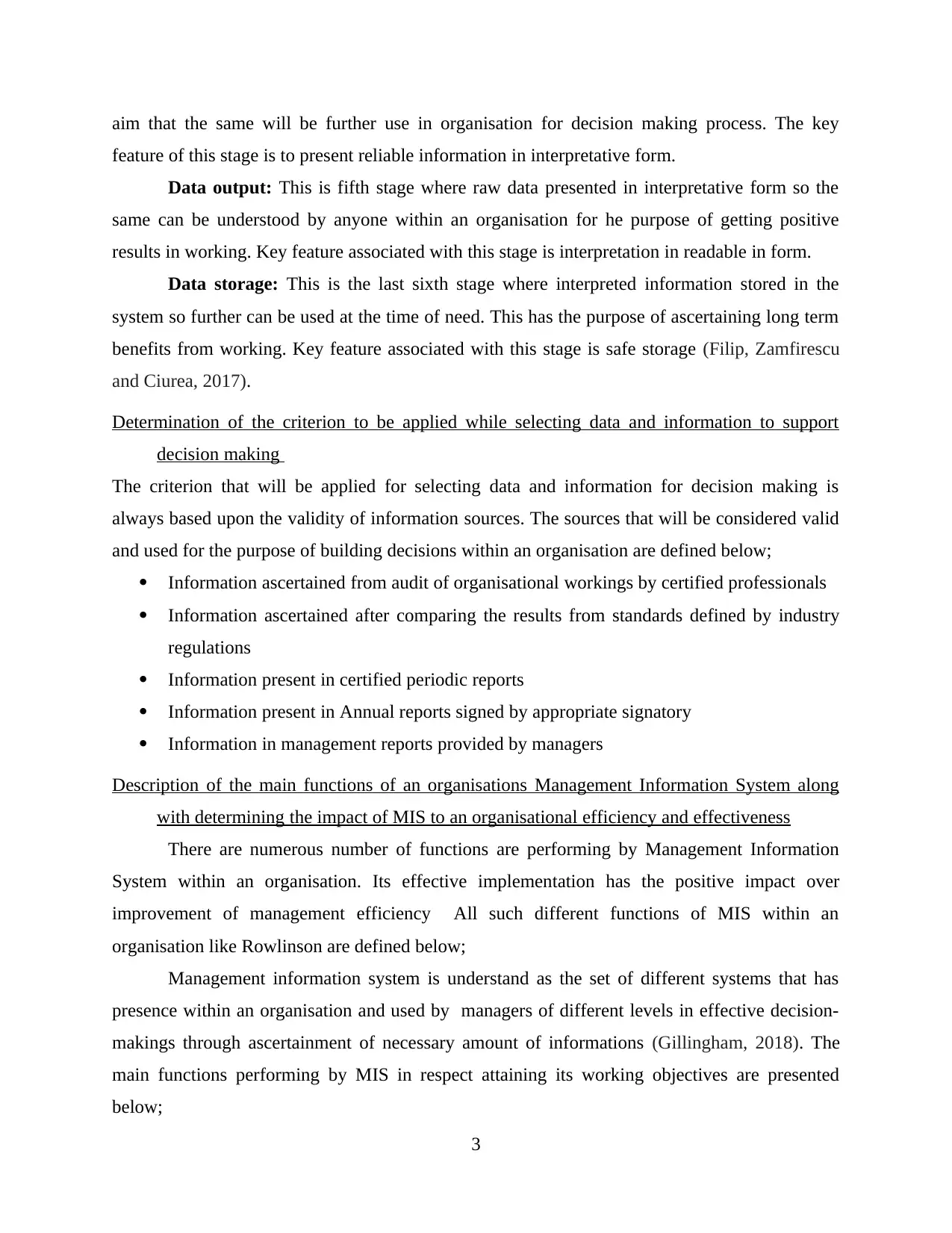
aim that the same will be further use in organisation for decision making process. The key
feature of this stage is to present reliable information in interpretative form.
Data output: This is fifth stage where raw data presented in interpretative form so the
same can be understood by anyone within an organisation for he purpose of getting positive
results in working. Key feature associated with this stage is interpretation in readable in form.
Data storage: This is the last sixth stage where interpreted information stored in the
system so further can be used at the time of need. This has the purpose of ascertaining long term
benefits from working. Key feature associated with this stage is safe storage (Filip, Zamfirescu
and Ciurea, 2017).
Determination of the criterion to be applied while selecting data and information to support
decision making
The criterion that will be applied for selecting data and information for decision making is
always based upon the validity of information sources. The sources that will be considered valid
and used for the purpose of building decisions within an organisation are defined below;
Information ascertained from audit of organisational workings by certified professionals
Information ascertained after comparing the results from standards defined by industry
regulations
Information present in certified periodic reports
Information present in Annual reports signed by appropriate signatory
Information in management reports provided by managers
Description of the main functions of an organisations Management Information System along
with determining the impact of MIS to an organisational efficiency and effectiveness
There are numerous number of functions are performing by Management Information
System within an organisation. Its effective implementation has the positive impact over
improvement of management efficiency All such different functions of MIS within an
organisation like Rowlinson are defined below;
Management information system is understand as the set of different systems that has
presence within an organisation and used by managers of different levels in effective decision-
makings through ascertainment of necessary amount of informations (Gillingham, 2018). The
main functions performing by MIS in respect attaining its working objectives are presented
below;
3
feature of this stage is to present reliable information in interpretative form.
Data output: This is fifth stage where raw data presented in interpretative form so the
same can be understood by anyone within an organisation for he purpose of getting positive
results in working. Key feature associated with this stage is interpretation in readable in form.
Data storage: This is the last sixth stage where interpreted information stored in the
system so further can be used at the time of need. This has the purpose of ascertaining long term
benefits from working. Key feature associated with this stage is safe storage (Filip, Zamfirescu
and Ciurea, 2017).
Determination of the criterion to be applied while selecting data and information to support
decision making
The criterion that will be applied for selecting data and information for decision making is
always based upon the validity of information sources. The sources that will be considered valid
and used for the purpose of building decisions within an organisation are defined below;
Information ascertained from audit of organisational workings by certified professionals
Information ascertained after comparing the results from standards defined by industry
regulations
Information present in certified periodic reports
Information present in Annual reports signed by appropriate signatory
Information in management reports provided by managers
Description of the main functions of an organisations Management Information System along
with determining the impact of MIS to an organisational efficiency and effectiveness
There are numerous number of functions are performing by Management Information
System within an organisation. Its effective implementation has the positive impact over
improvement of management efficiency All such different functions of MIS within an
organisation like Rowlinson are defined below;
Management information system is understand as the set of different systems that has
presence within an organisation and used by managers of different levels in effective decision-
makings through ascertainment of necessary amount of informations (Gillingham, 2018). The
main functions performing by MIS in respect attaining its working objectives are presented
below;
3
⊘ This is a preview!⊘
Do you want full access?
Subscribe today to unlock all pages.

Trusted by 1+ million students worldwide
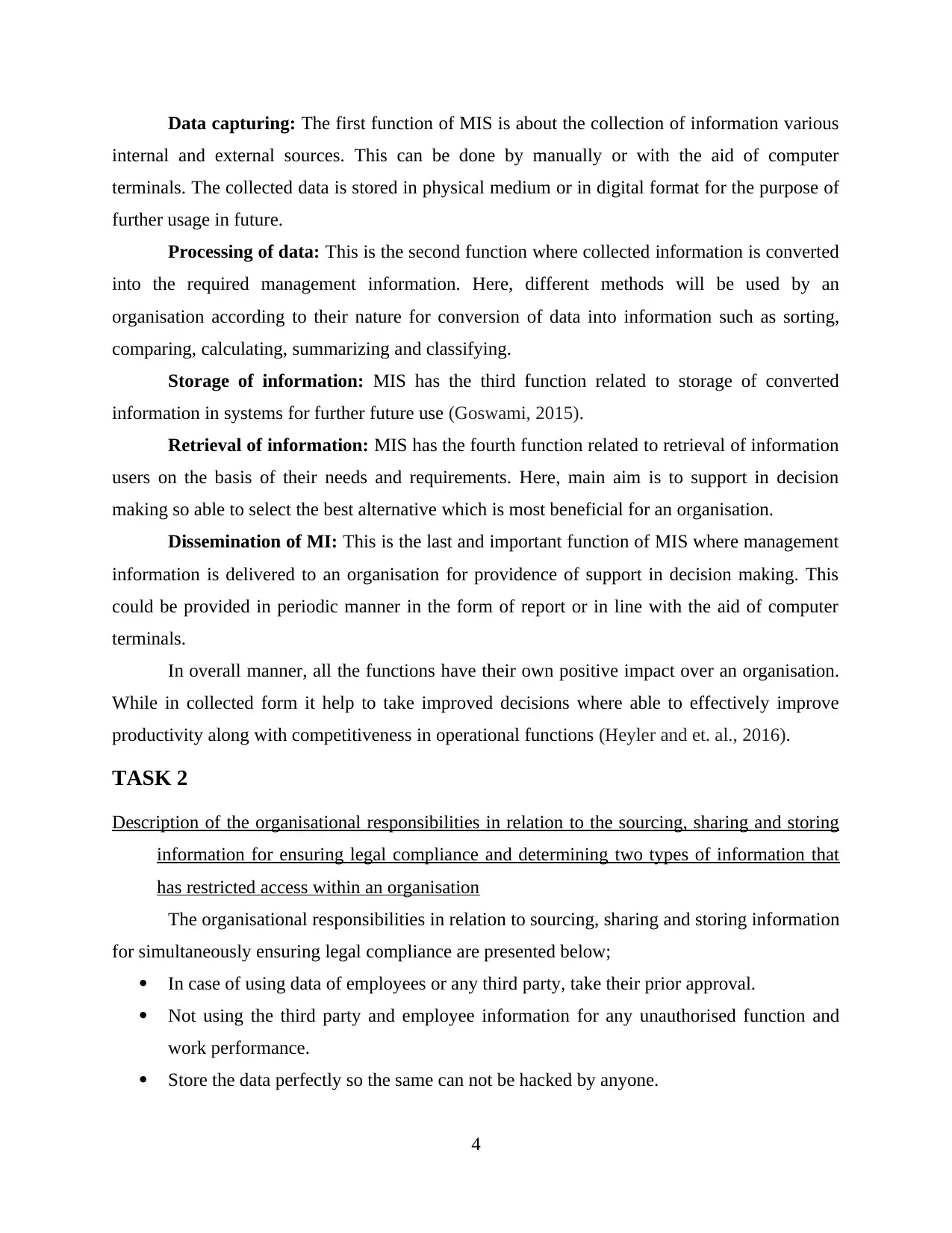
Data capturing: The first function of MIS is about the collection of information various
internal and external sources. This can be done by manually or with the aid of computer
terminals. The collected data is stored in physical medium or in digital format for the purpose of
further usage in future.
Processing of data: This is the second function where collected information is converted
into the required management information. Here, different methods will be used by an
organisation according to their nature for conversion of data into information such as sorting,
comparing, calculating, summarizing and classifying.
Storage of information: MIS has the third function related to storage of converted
information in systems for further future use (Goswami, 2015).
Retrieval of information: MIS has the fourth function related to retrieval of information
users on the basis of their needs and requirements. Here, main aim is to support in decision
making so able to select the best alternative which is most beneficial for an organisation.
Dissemination of MI: This is the last and important function of MIS where management
information is delivered to an organisation for providence of support in decision making. This
could be provided in periodic manner in the form of report or in line with the aid of computer
terminals.
In overall manner, all the functions have their own positive impact over an organisation.
While in collected form it help to take improved decisions where able to effectively improve
productivity along with competitiveness in operational functions (Heyler and et. al., 2016).
TASK 2
Description of the organisational responsibilities in relation to the sourcing, sharing and storing
information for ensuring legal compliance and determining two types of information that
has restricted access within an organisation
The organisational responsibilities in relation to sourcing, sharing and storing information
for simultaneously ensuring legal compliance are presented below;
In case of using data of employees or any third party, take their prior approval.
Not using the third party and employee information for any unauthorised function and
work performance.
Store the data perfectly so the same can not be hacked by anyone.
4
internal and external sources. This can be done by manually or with the aid of computer
terminals. The collected data is stored in physical medium or in digital format for the purpose of
further usage in future.
Processing of data: This is the second function where collected information is converted
into the required management information. Here, different methods will be used by an
organisation according to their nature for conversion of data into information such as sorting,
comparing, calculating, summarizing and classifying.
Storage of information: MIS has the third function related to storage of converted
information in systems for further future use (Goswami, 2015).
Retrieval of information: MIS has the fourth function related to retrieval of information
users on the basis of their needs and requirements. Here, main aim is to support in decision
making so able to select the best alternative which is most beneficial for an organisation.
Dissemination of MI: This is the last and important function of MIS where management
information is delivered to an organisation for providence of support in decision making. This
could be provided in periodic manner in the form of report or in line with the aid of computer
terminals.
In overall manner, all the functions have their own positive impact over an organisation.
While in collected form it help to take improved decisions where able to effectively improve
productivity along with competitiveness in operational functions (Heyler and et. al., 2016).
TASK 2
Description of the organisational responsibilities in relation to the sourcing, sharing and storing
information for ensuring legal compliance and determining two types of information that
has restricted access within an organisation
The organisational responsibilities in relation to sourcing, sharing and storing information
for simultaneously ensuring legal compliance are presented below;
In case of using data of employees or any third party, take their prior approval.
Not using the third party and employee information for any unauthorised function and
work performance.
Store the data perfectly so the same can not be hacked by anyone.
4
Paraphrase This Document
Need a fresh take? Get an instant paraphrase of this document with our AI Paraphraser
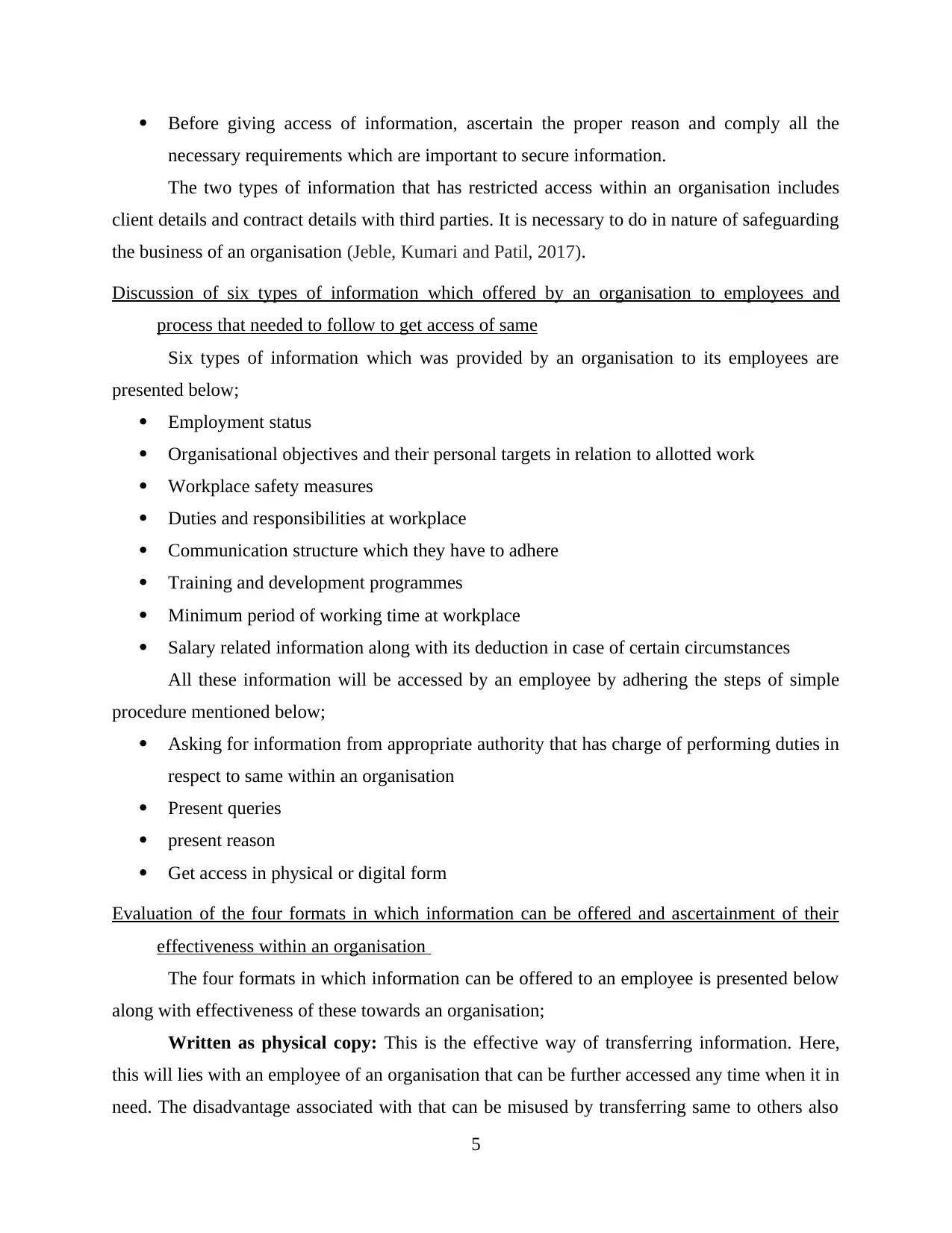
Before giving access of information, ascertain the proper reason and comply all the
necessary requirements which are important to secure information.
The two types of information that has restricted access within an organisation includes
client details and contract details with third parties. It is necessary to do in nature of safeguarding
the business of an organisation (Jeble, Kumari and Patil, 2017).
Discussion of six types of information which offered by an organisation to employees and
process that needed to follow to get access of same
Six types of information which was provided by an organisation to its employees are
presented below;
Employment status
Organisational objectives and their personal targets in relation to allotted work
Workplace safety measures
Duties and responsibilities at workplace
Communication structure which they have to adhere
Training and development programmes
Minimum period of working time at workplace
Salary related information along with its deduction in case of certain circumstances
All these information will be accessed by an employee by adhering the steps of simple
procedure mentioned below;
Asking for information from appropriate authority that has charge of performing duties in
respect to same within an organisation
Present queries
present reason
Get access in physical or digital form
Evaluation of the four formats in which information can be offered and ascertainment of their
effectiveness within an organisation
The four formats in which information can be offered to an employee is presented below
along with effectiveness of these towards an organisation;
Written as physical copy: This is the effective way of transferring information. Here,
this will lies with an employee of an organisation that can be further accessed any time when it in
need. The disadvantage associated with that can be misused by transferring same to others also
5
necessary requirements which are important to secure information.
The two types of information that has restricted access within an organisation includes
client details and contract details with third parties. It is necessary to do in nature of safeguarding
the business of an organisation (Jeble, Kumari and Patil, 2017).
Discussion of six types of information which offered by an organisation to employees and
process that needed to follow to get access of same
Six types of information which was provided by an organisation to its employees are
presented below;
Employment status
Organisational objectives and their personal targets in relation to allotted work
Workplace safety measures
Duties and responsibilities at workplace
Communication structure which they have to adhere
Training and development programmes
Minimum period of working time at workplace
Salary related information along with its deduction in case of certain circumstances
All these information will be accessed by an employee by adhering the steps of simple
procedure mentioned below;
Asking for information from appropriate authority that has charge of performing duties in
respect to same within an organisation
Present queries
present reason
Get access in physical or digital form
Evaluation of the four formats in which information can be offered and ascertainment of their
effectiveness within an organisation
The four formats in which information can be offered to an employee is presented below
along with effectiveness of these towards an organisation;
Written as physical copy: This is the effective way of transferring information. Here,
this will lies with an employee of an organisation that can be further accessed any time when it in
need. The disadvantage associated with that can be misused by transferring same to others also
5
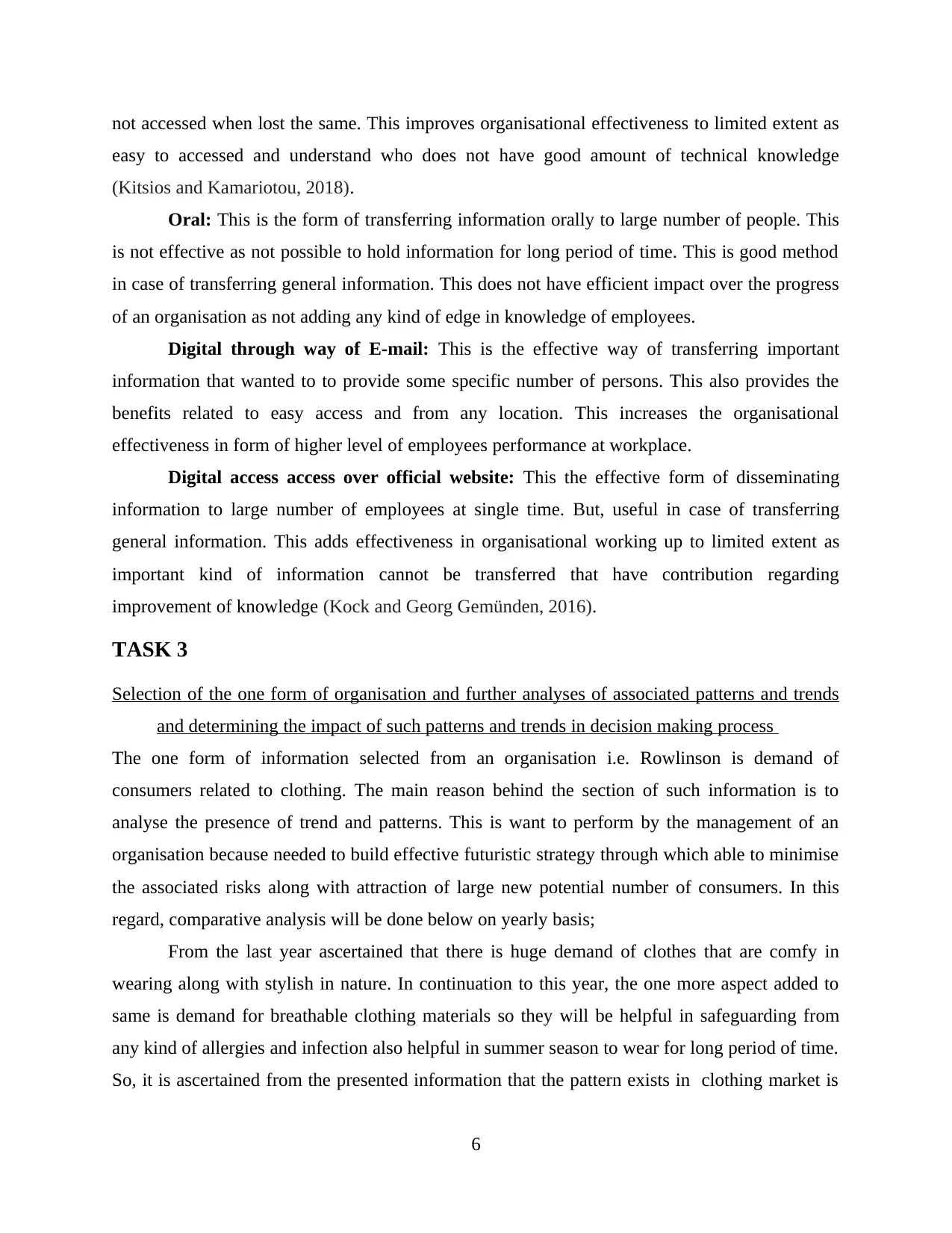
not accessed when lost the same. This improves organisational effectiveness to limited extent as
easy to accessed and understand who does not have good amount of technical knowledge
(Kitsios and Kamariotou, 2018).
Oral: This is the form of transferring information orally to large number of people. This
is not effective as not possible to hold information for long period of time. This is good method
in case of transferring general information. This does not have efficient impact over the progress
of an organisation as not adding any kind of edge in knowledge of employees.
Digital through way of E-mail: This is the effective way of transferring important
information that wanted to to provide some specific number of persons. This also provides the
benefits related to easy access and from any location. This increases the organisational
effectiveness in form of higher level of employees performance at workplace.
Digital access access over official website: This the effective form of disseminating
information to large number of employees at single time. But, useful in case of transferring
general information. This adds effectiveness in organisational working up to limited extent as
important kind of information cannot be transferred that have contribution regarding
improvement of knowledge (Kock and Georg Gemünden, 2016).
TASK 3
Selection of the one form of organisation and further analyses of associated patterns and trends
and determining the impact of such patterns and trends in decision making process
The one form of information selected from an organisation i.e. Rowlinson is demand of
consumers related to clothing. The main reason behind the section of such information is to
analyse the presence of trend and patterns. This is want to perform by the management of an
organisation because needed to build effective futuristic strategy through which able to minimise
the associated risks along with attraction of large new potential number of consumers. In this
regard, comparative analysis will be done below on yearly basis;
From the last year ascertained that there is huge demand of clothes that are comfy in
wearing along with stylish in nature. In continuation to this year, the one more aspect added to
same is demand for breathable clothing materials so they will be helpful in safeguarding from
any kind of allergies and infection also helpful in summer season to wear for long period of time.
So, it is ascertained from the presented information that the pattern exists in clothing market is
6
easy to accessed and understand who does not have good amount of technical knowledge
(Kitsios and Kamariotou, 2018).
Oral: This is the form of transferring information orally to large number of people. This
is not effective as not possible to hold information for long period of time. This is good method
in case of transferring general information. This does not have efficient impact over the progress
of an organisation as not adding any kind of edge in knowledge of employees.
Digital through way of E-mail: This is the effective way of transferring important
information that wanted to to provide some specific number of persons. This also provides the
benefits related to easy access and from any location. This increases the organisational
effectiveness in form of higher level of employees performance at workplace.
Digital access access over official website: This the effective form of disseminating
information to large number of employees at single time. But, useful in case of transferring
general information. This adds effectiveness in organisational working up to limited extent as
important kind of information cannot be transferred that have contribution regarding
improvement of knowledge (Kock and Georg Gemünden, 2016).
TASK 3
Selection of the one form of organisation and further analyses of associated patterns and trends
and determining the impact of such patterns and trends in decision making process
The one form of information selected from an organisation i.e. Rowlinson is demand of
consumers related to clothing. The main reason behind the section of such information is to
analyse the presence of trend and patterns. This is want to perform by the management of an
organisation because needed to build effective futuristic strategy through which able to minimise
the associated risks along with attraction of large new potential number of consumers. In this
regard, comparative analysis will be done below on yearly basis;
From the last year ascertained that there is huge demand of clothes that are comfy in
wearing along with stylish in nature. In continuation to this year, the one more aspect added to
same is demand for breathable clothing materials so they will be helpful in safeguarding from
any kind of allergies and infection also helpful in summer season to wear for long period of time.
So, it is ascertained from the presented information that the pattern exists in clothing market is
6
⊘ This is a preview!⊘
Do you want full access?
Subscribe today to unlock all pages.

Trusted by 1+ million students worldwide
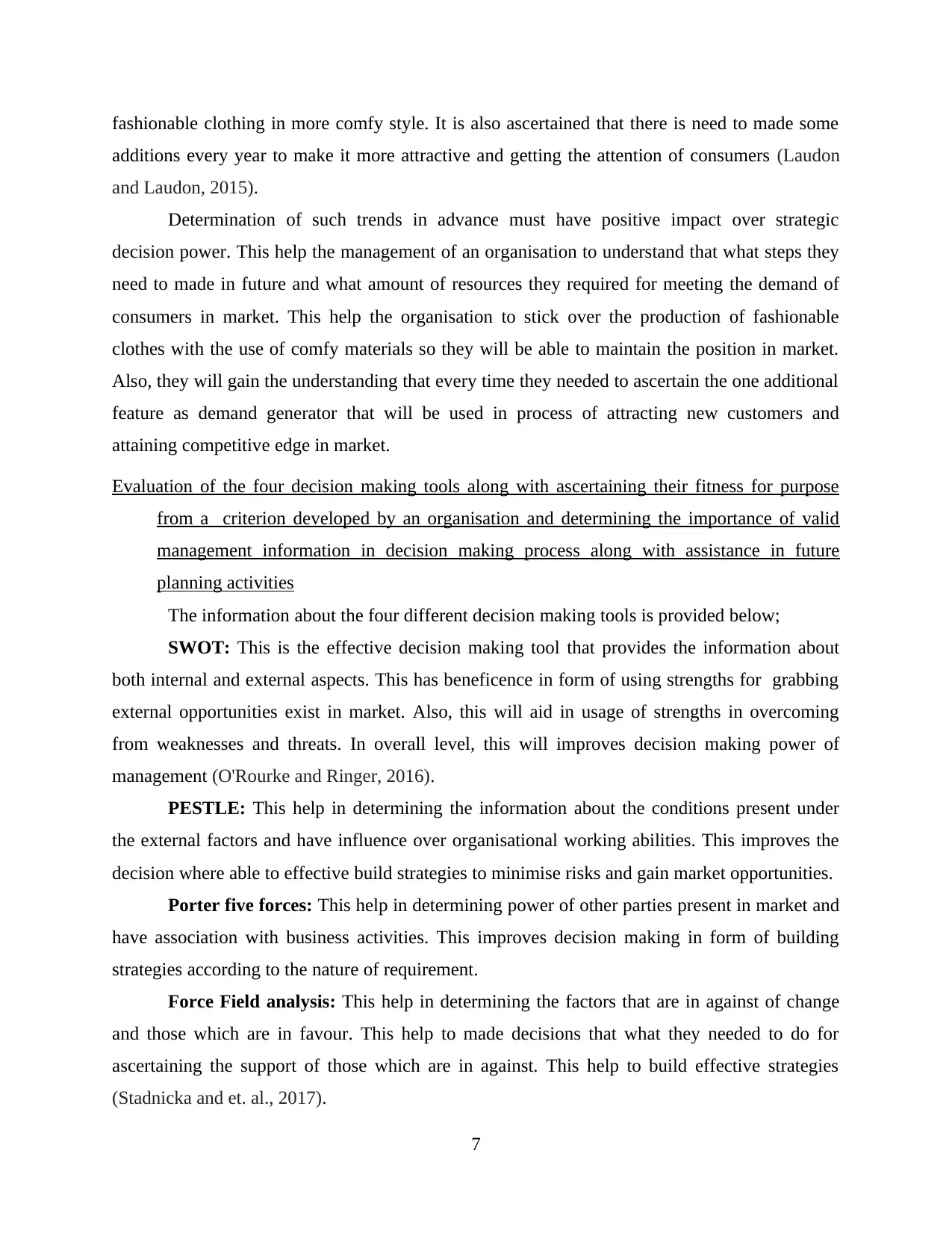
fashionable clothing in more comfy style. It is also ascertained that there is need to made some
additions every year to make it more attractive and getting the attention of consumers (Laudon
and Laudon, 2015).
Determination of such trends in advance must have positive impact over strategic
decision power. This help the management of an organisation to understand that what steps they
need to made in future and what amount of resources they required for meeting the demand of
consumers in market. This help the organisation to stick over the production of fashionable
clothes with the use of comfy materials so they will be able to maintain the position in market.
Also, they will gain the understanding that every time they needed to ascertain the one additional
feature as demand generator that will be used in process of attracting new customers and
attaining competitive edge in market.
Evaluation of the four decision making tools along with ascertaining their fitness for purpose
from a criterion developed by an organisation and determining the importance of valid
management information in decision making process along with assistance in future
planning activities
The information about the four different decision making tools is provided below;
SWOT: This is the effective decision making tool that provides the information about
both internal and external aspects. This has beneficence in form of using strengths for grabbing
external opportunities exist in market. Also, this will aid in usage of strengths in overcoming
from weaknesses and threats. In overall level, this will improves decision making power of
management (O'Rourke and Ringer, 2016).
PESTLE: This help in determining the information about the conditions present under
the external factors and have influence over organisational working abilities. This improves the
decision where able to effective build strategies to minimise risks and gain market opportunities.
Porter five forces: This help in determining power of other parties present in market and
have association with business activities. This improves decision making in form of building
strategies according to the nature of requirement.
Force Field analysis: This help in determining the factors that are in against of change
and those which are in favour. This help to made decisions that what they needed to do for
ascertaining the support of those which are in against. This help to build effective strategies
(Stadnicka and et. al., 2017).
7
additions every year to make it more attractive and getting the attention of consumers (Laudon
and Laudon, 2015).
Determination of such trends in advance must have positive impact over strategic
decision power. This help the management of an organisation to understand that what steps they
need to made in future and what amount of resources they required for meeting the demand of
consumers in market. This help the organisation to stick over the production of fashionable
clothes with the use of comfy materials so they will be able to maintain the position in market.
Also, they will gain the understanding that every time they needed to ascertain the one additional
feature as demand generator that will be used in process of attracting new customers and
attaining competitive edge in market.
Evaluation of the four decision making tools along with ascertaining their fitness for purpose
from a criterion developed by an organisation and determining the importance of valid
management information in decision making process along with assistance in future
planning activities
The information about the four different decision making tools is provided below;
SWOT: This is the effective decision making tool that provides the information about
both internal and external aspects. This has beneficence in form of using strengths for grabbing
external opportunities exist in market. Also, this will aid in usage of strengths in overcoming
from weaknesses and threats. In overall level, this will improves decision making power of
management (O'Rourke and Ringer, 2016).
PESTLE: This help in determining the information about the conditions present under
the external factors and have influence over organisational working abilities. This improves the
decision where able to effective build strategies to minimise risks and gain market opportunities.
Porter five forces: This help in determining power of other parties present in market and
have association with business activities. This improves decision making in form of building
strategies according to the nature of requirement.
Force Field analysis: This help in determining the factors that are in against of change
and those which are in favour. This help to made decisions that what they needed to do for
ascertaining the support of those which are in against. This help to build effective strategies
(Stadnicka and et. al., 2017).
7
Paraphrase This Document
Need a fresh take? Get an instant paraphrase of this document with our AI Paraphraser
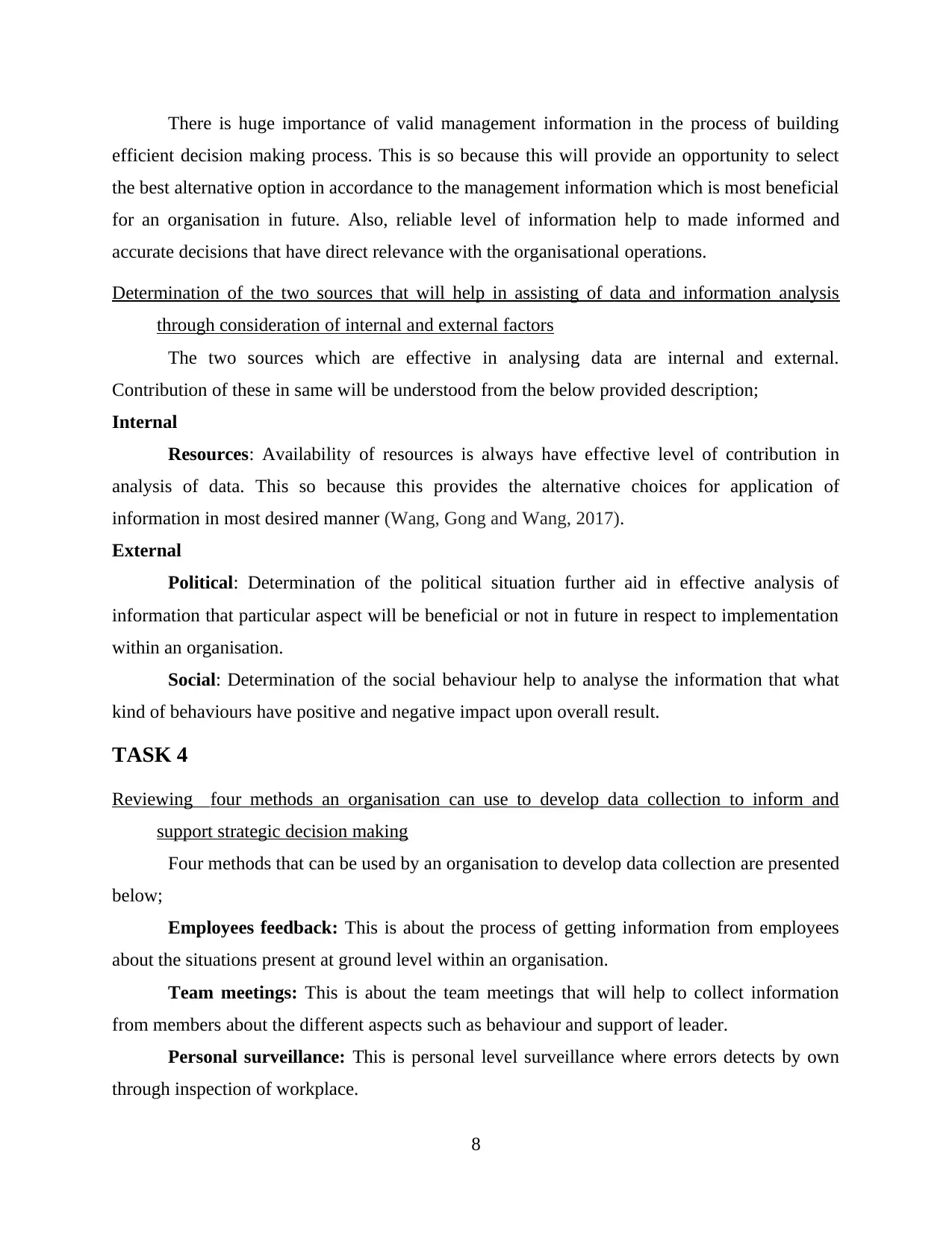
There is huge importance of valid management information in the process of building
efficient decision making process. This is so because this will provide an opportunity to select
the best alternative option in accordance to the management information which is most beneficial
for an organisation in future. Also, reliable level of information help to made informed and
accurate decisions that have direct relevance with the organisational operations.
Determination of the two sources that will help in assisting of data and information analysis
through consideration of internal and external factors
The two sources which are effective in analysing data are internal and external.
Contribution of these in same will be understood from the below provided description;
Internal
Resources: Availability of resources is always have effective level of contribution in
analysis of data. This so because this provides the alternative choices for application of
information in most desired manner (Wang, Gong and Wang, 2017).
External
Political: Determination of the political situation further aid in effective analysis of
information that particular aspect will be beneficial or not in future in respect to implementation
within an organisation.
Social: Determination of the social behaviour help to analyse the information that what
kind of behaviours have positive and negative impact upon overall result.
TASK 4
Reviewing four methods an organisation can use to develop data collection to inform and
support strategic decision making
Four methods that can be used by an organisation to develop data collection are presented
below;
Employees feedback: This is about the process of getting information from employees
about the situations present at ground level within an organisation.
Team meetings: This is about the team meetings that will help to collect information
from members about the different aspects such as behaviour and support of leader.
Personal surveillance: This is personal level surveillance where errors detects by own
through inspection of workplace.
8
efficient decision making process. This is so because this will provide an opportunity to select
the best alternative option in accordance to the management information which is most beneficial
for an organisation in future. Also, reliable level of information help to made informed and
accurate decisions that have direct relevance with the organisational operations.
Determination of the two sources that will help in assisting of data and information analysis
through consideration of internal and external factors
The two sources which are effective in analysing data are internal and external.
Contribution of these in same will be understood from the below provided description;
Internal
Resources: Availability of resources is always have effective level of contribution in
analysis of data. This so because this provides the alternative choices for application of
information in most desired manner (Wang, Gong and Wang, 2017).
External
Political: Determination of the political situation further aid in effective analysis of
information that particular aspect will be beneficial or not in future in respect to implementation
within an organisation.
Social: Determination of the social behaviour help to analyse the information that what
kind of behaviours have positive and negative impact upon overall result.
TASK 4
Reviewing four methods an organisation can use to develop data collection to inform and
support strategic decision making
Four methods that can be used by an organisation to develop data collection are presented
below;
Employees feedback: This is about the process of getting information from employees
about the situations present at ground level within an organisation.
Team meetings: This is about the team meetings that will help to collect information
from members about the different aspects such as behaviour and support of leader.
Personal surveillance: This is personal level surveillance where errors detects by own
through inspection of workplace.
8
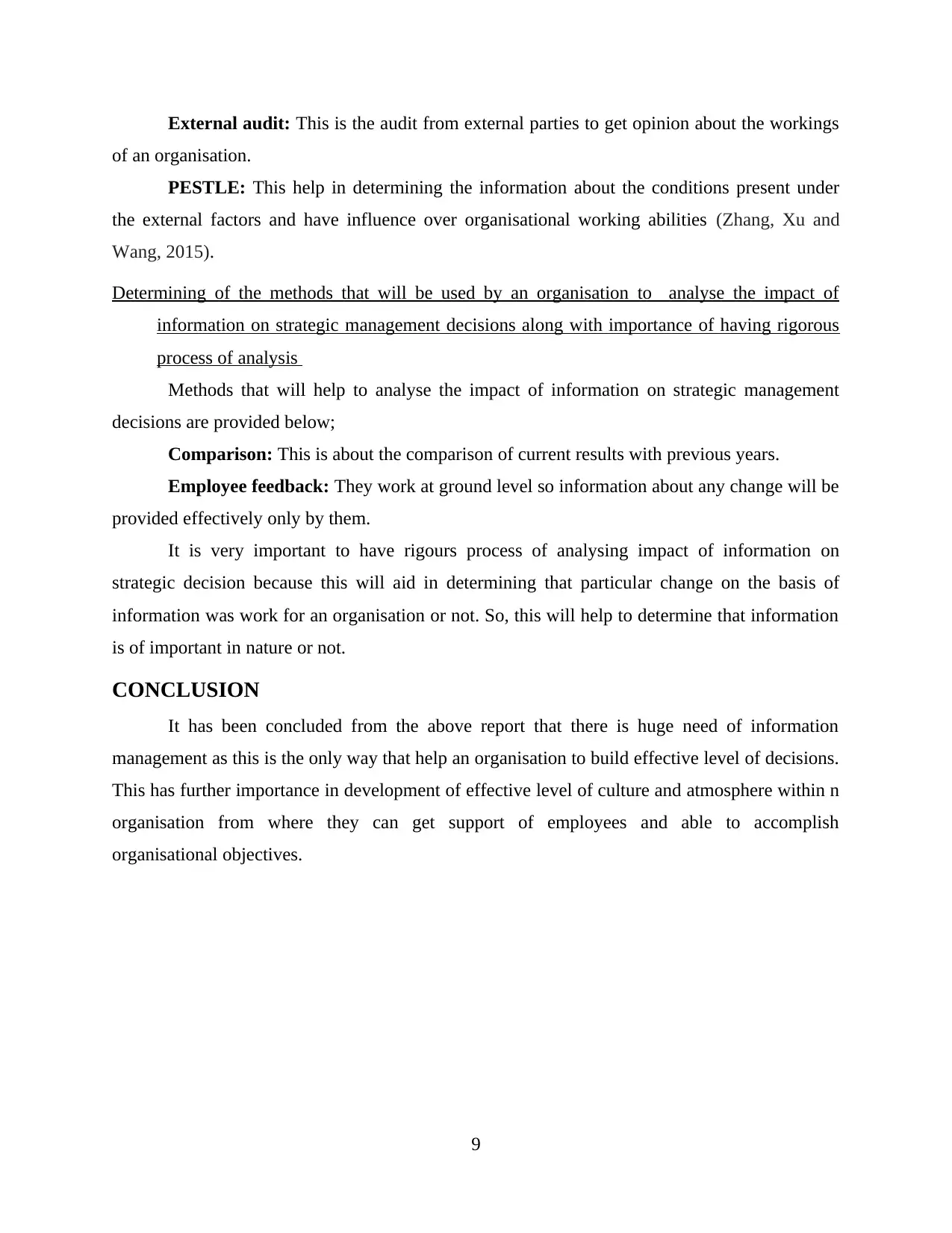
External audit: This is the audit from external parties to get opinion about the workings
of an organisation.
PESTLE: This help in determining the information about the conditions present under
the external factors and have influence over organisational working abilities (Zhang, Xu and
Wang, 2015).
Determining of the methods that will be used by an organisation to analyse the impact of
information on strategic management decisions along with importance of having rigorous
process of analysis
Methods that will help to analyse the impact of information on strategic management
decisions are provided below;
Comparison: This is about the comparison of current results with previous years.
Employee feedback: They work at ground level so information about any change will be
provided effectively only by them.
It is very important to have rigours process of analysing impact of information on
strategic decision because this will aid in determining that particular change on the basis of
information was work for an organisation or not. So, this will help to determine that information
is of important in nature or not.
CONCLUSION
It has been concluded from the above report that there is huge need of information
management as this is the only way that help an organisation to build effective level of decisions.
This has further importance in development of effective level of culture and atmosphere within n
organisation from where they can get support of employees and able to accomplish
organisational objectives.
9
of an organisation.
PESTLE: This help in determining the information about the conditions present under
the external factors and have influence over organisational working abilities (Zhang, Xu and
Wang, 2015).
Determining of the methods that will be used by an organisation to analyse the impact of
information on strategic management decisions along with importance of having rigorous
process of analysis
Methods that will help to analyse the impact of information on strategic management
decisions are provided below;
Comparison: This is about the comparison of current results with previous years.
Employee feedback: They work at ground level so information about any change will be
provided effectively only by them.
It is very important to have rigours process of analysing impact of information on
strategic decision because this will aid in determining that particular change on the basis of
information was work for an organisation or not. So, this will help to determine that information
is of important in nature or not.
CONCLUSION
It has been concluded from the above report that there is huge need of information
management as this is the only way that help an organisation to build effective level of decisions.
This has further importance in development of effective level of culture and atmosphere within n
organisation from where they can get support of employees and able to accomplish
organisational objectives.
9
⊘ This is a preview!⊘
Do you want full access?
Subscribe today to unlock all pages.

Trusted by 1+ million students worldwide
1 out of 14
Related Documents
Your All-in-One AI-Powered Toolkit for Academic Success.
+13062052269
info@desklib.com
Available 24*7 on WhatsApp / Email
![[object Object]](/_next/static/media/star-bottom.7253800d.svg)
Unlock your academic potential
Copyright © 2020–2025 A2Z Services. All Rights Reserved. Developed and managed by ZUCOL.





